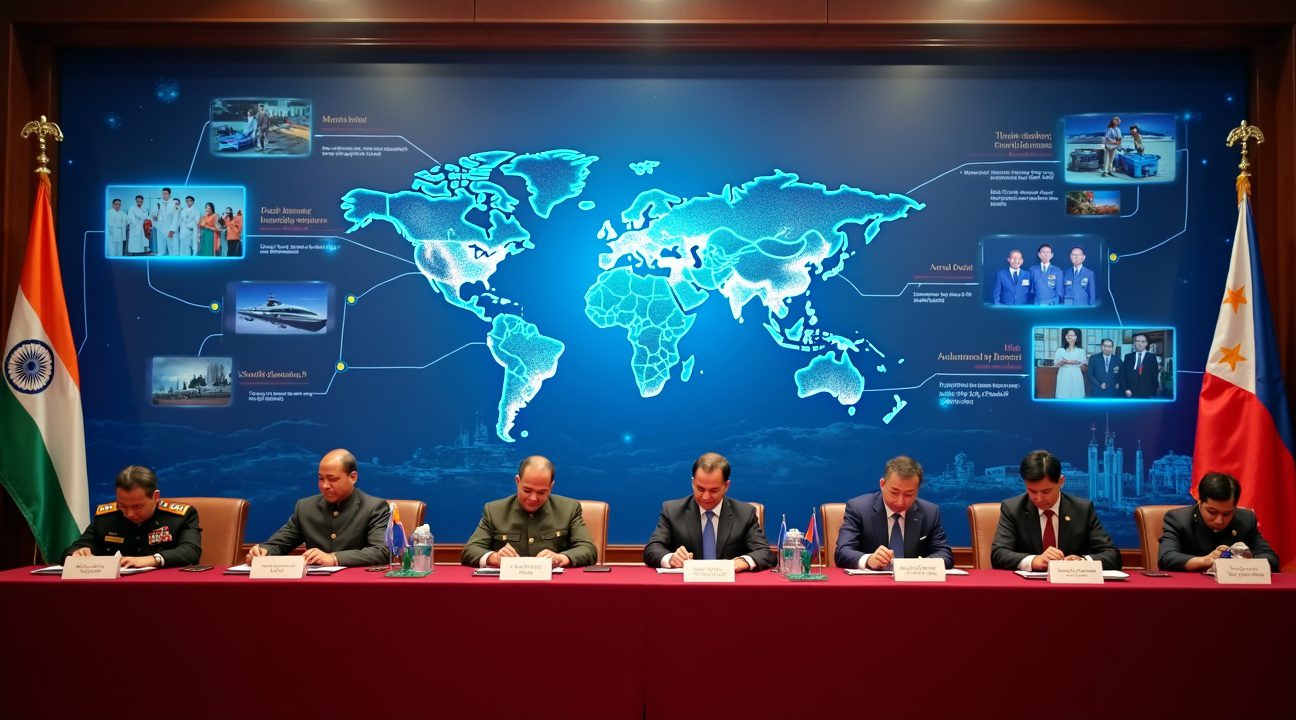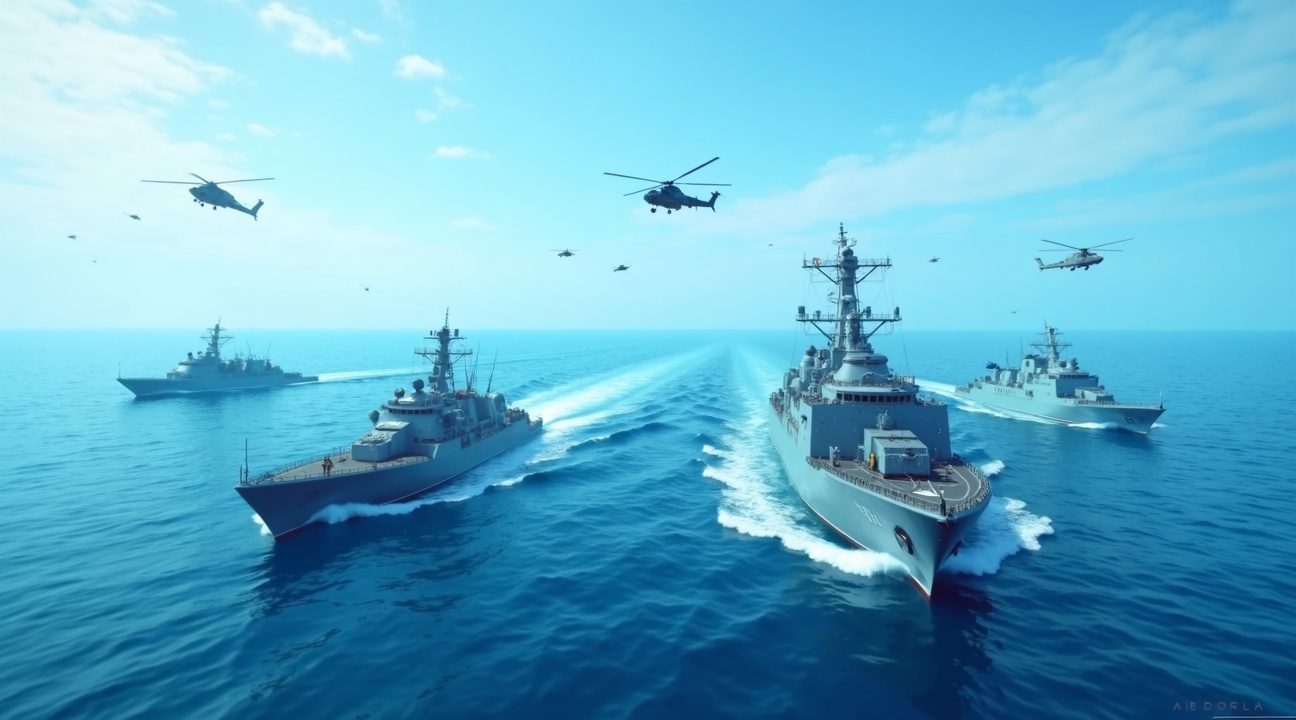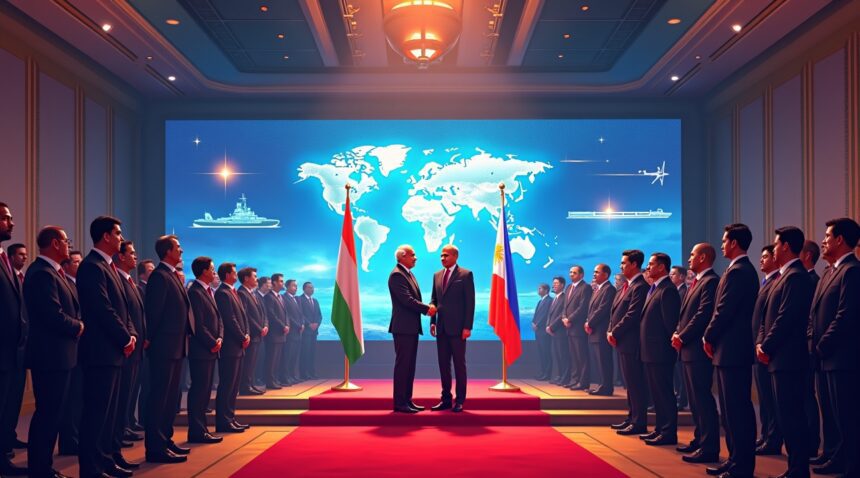India and the Philippines elevated their bilateral relationship to Strategic Partnership status on August 5, 2025, marking a historic development in Asia’s geopolitical landscape.
Key Takeaways
- Exclusive Strategic Partnership: The Philippines joins an elite group of only five nations that hold Strategic Partnership status with India, reflecting the increasing depth and importance of their cooperation across national and regional issues.
- Comprehensive Defense Cooperation: Military pacts include Army-to-Army, Navy-to-Navy, and Air Force Staff Talks. The two countries are planning joint exercises in the South China Sea to jointly address mutual regional security concerns.
- Record Trade Growth: Bilateral trade surged to $3.3 billion in 2024-25, reflecting a 76% increase since 2013 and 63% since 2019-20. India’s pharmaceutical sector continues to dominate exports to the Philippines.
- Massive Investment Commitment: India has pledged over $5 billion in investments in the Philippines, which includes $1.2 billion in direct foreign investment. This also involves significant technology transfers in infrastructure sectors.
- Regional Leadership Framework: In a united front, India and the Philippines reaffirmed their support for ASEAN centrality, a rules-based Indo-Pacific, and joint efforts in advocating for UN Security Council reform.
Historic Milestone: Philippines Becomes India’s Fifth Strategic Partner
On August 5, 2025, India and the Philippines marked a significant diplomatic achievement by elevating their bilateral relationship to a Strategic Partnership status. This milestone places the Philippines among an exclusive group of only five nations that have achieved this elevated partnership with India, underscoring the growing importance of their relationship in regional geopolitics.
President Ferdinand Marcos Jr. led an impressive delegation of 14 Philippine cabinet ministers to India to formalize this groundbreaking agreement. The high-level visit demonstrates both countries’ commitment to strengthening their ties across multiple sectors. Prime Minister Modi welcomed the Philippine delegation, emphasizing the shared vision for regional cooperation and mutual prosperity.
Comprehensive Framework for Future Cooperation
The Strategic Partnership establishes a detailed Plan of Action spanning 2025–2029, creating a structured roadmap for enhanced collaboration. This comprehensive framework addresses several critical areas that will shape the future of India-Philippines relations:
- Political cooperation through regular high-level exchanges and diplomatic consultations
- Economic partnerships focusing on trade, investment, and infrastructure development
- Security collaboration including maritime security and counter-terrorism efforts
- Technological cooperation in emerging fields like digital innovation and space exploration
- Cultural and educational exchanges to strengthen people-to-people connections
Both nations have committed to promoting peace, prosperity, and stability throughout the broader Indo-Pacific region. The partnership strongly emphasizes maintaining a free, open, and rules-based regional order, which aligns with both countries’ strategic interests. This approach recognizes ASEAN centrality while fostering deeper bilateral ties that complement existing multilateral frameworks.
The agreement reflects India’s growing influence in Southeast Asian affairs and the Philippines’ strategic positioning in regional security architecture. President Marcos and Prime Minister Modi have articulated a shared vision that extends beyond bilateral interests to encompass regional stability and economic growth. The Strategic Partnership creates new opportunities for cooperation in defense technology, renewable energy, and digital infrastructure, areas where both countries see significant potential for mutual benefit.
This elevation in diplomatic status comes at a crucial time when both nations face complex regional challenges. India’s space missions have demonstrated technological capabilities that could benefit Philippine development goals, while the Philippines’ strategic location offers India enhanced access to Southeast Asian markets and security cooperation opportunities. The partnership strengthens both countries’ positions in addressing maritime security concerns and promoting economic integration across the Indo-Pacific region.

Fourteen Major Agreements Signed to Strengthen Bilateral Ties
I observed a comprehensive diplomatic breakthrough as the Philippines and India formalized their strategic partnership through fourteen formal agreements and memoranda of understanding in 2025. These agreements span multiple critical sectors, demonstrating both nations’ commitment to deeper cooperation across diverse areas of mutual interest.
Military and Defense Cooperation Takes Center Stage
Defense collaboration emerged as a cornerstone of this partnership, with several groundbreaking military agreements taking effect. The establishment of Army-to-Army, Navy-to-Navy, and Air Force Staff Talks creates structured channels for ongoing military dialogue between both nations. These frameworks will facilitate joint military exercises planned specifically for the South China Sea, a strategically vital region where both countries share common security interests.
Additional memoranda of understanding covering dialogue between armed forces strengthen the foundation for future military cooperation. I notice these agreements position both nations to address shared maritime security challenges while building operational interoperability between their respective military forces. The inclusion of India’s technological capabilities in defense collaboration adds another dimension to this partnership.
Legal and Technology Frameworks Drive Innovation
Beyond military cooperation, significant progress occurred in legal frameworks and technological advancement. Treaties covering Mutual Legal Assistance in Criminal Matters and Transfer of Sentenced Persons establish important judicial cooperation mechanisms. These agreements enable both countries to collaborate more effectively in addressing transnational crime and supporting their respective justice systems.
The Programme of Cooperation in Science and Technology (2025–2028) creates a structured approach to innovation and research exchanges between Filipino and Indian institutions. This agreement focuses on spurring technological advancement through shared expertise and collaborative research initiatives. Digital technology cooperation receives particular emphasis through dedicated memoranda of understanding, reflecting both nations’ priorities in digital transformation.
Focus Areas of Cooperation
- Security cooperation through enhanced military dialogue and joint exercises
- Trade facilitation and economic partnership development
- Healthcare collaboration and medical technology sharing
- Digital transformation initiatives and technology transfer
- Legal cooperation in criminal matters and judicial assistance
- Connectivity projects linking both nations’ infrastructure
- Tourism promotion and cultural exchange programs
I find the scope of these agreements particularly impressive because they address both immediate security concerns and long-term economic development goals. The emphasis on digital transformation aligns with global technological trends while the tourism cooperation opens new avenues for people-to-people connections.
Healthcare collaboration represents another vital component, potentially enabling knowledge sharing in medical research and public health initiatives. Connectivity projects promise to strengthen physical and digital links between the two nations, facilitating trade and communication.
The timing of these agreements reflects strategic foresight from both governments, as they recognize the importance of deepening bilateral ties in an increasingly complex geopolitical environment. Science and technology cooperation will likely drive innovation in multiple sectors, from agriculture to defense applications.
Tourism agreements open pathways for increased cultural exchange and economic benefits for both nations. These partnerships could mirror successful collaborations seen in other international contexts, such as entertainment industry partnerships that boost cultural understanding.
The comprehensive nature of these fourteen agreements demonstrates that both countries view this strategic partnership as more than a diplomatic formality. Each agreement contains specific implementation mechanisms and timelines, ensuring concrete progress rather than symbolic gestures. Digital transformation initiatives will particularly benefit both nations as they modernize their economies and governance systems.
Legal cooperation frameworks provide essential tools for addressing shared challenges in law enforcement and criminal justice. The mutual assistance treaties create pathways for information sharing and coordinated responses to transnational crimes that affect both countries.

Booming Trade Relations Reach Record $3.3 Billion
I’ve witnessed an extraordinary transformation in Philippine-Indian economic relations, with bilateral trade experiencing explosive growth that has redefined the partnership between these two nations. The numbers tell a compelling story of deepening cooperation, with trade volumes surging an impressive 76% since 2013 to reach a record-breaking $3.3 billion in 2024-25.
The most remarkable acceleration occurred in recent years, with a substantial 63% increase since 2019-20 alone. This dramatic uptick demonstrates how both countries have capitalized on emerging opportunities and strengthened their economic foundations. India’s export performance has been particularly strong, reaching approximately $2.2 billion in 2024, while imports from the Philippines totaled about $1.17 billion.
Strategic Export Portfolio Drives Growth
India’s export strategy has proven highly effective, with pharmaceuticals leading the charge as the star performer. The pharmaceutical sector has experienced remarkable growth of 65% since 2019, generating $401.95 million in 2024. This surge reflects India’s established position as a global pharmaceutical powerhouse and the Philippines’ growing healthcare needs.
Vehicle exports have also contributed significantly to the trade boom, reaching $267.04 million, while machinery exports added another $117.28 million to the total. These sectors showcase India’s manufacturing capabilities and technological advancement, much like India’s space achievements that have garnered international attention.
The Philippines now represents 1.7% of India’s total imports and 1.5% of its exports, marking an all-time high in bilateral engagement. These percentages might seem modest, but they represent tremendous potential for future expansion as both economies continue growing.
Both nations are actively pursuing deeper integration through negotiations on a preferential trade agreement. This initiative builds upon the existing ASEAN Free Trade Area framework, which has already facilitated smoother trade flows between the regions. The proposed agreement would create additional opportunities for businesses on both sides while reducing barriers that currently limit trade potential.
The momentum behind these trade relations extends beyond simple commerce. Companies in both countries are discovering new partnership opportunities, whether in technology transfer, joint ventures, or supply chain integration. This economic foundation provides stability for the broader strategic partnership that both nations are cultivating across multiple sectors.
Current trends suggest this growth trajectory will continue, with both governments committed to expanding trade volumes further. The success of sectors like pharmaceuticals and vehicles demonstrates how targeted cooperation can yield substantial results, setting the stage for similar achievements in other industries.

Massive $5 Billion Indian Investment Commitment
Indian investments in the Philippines have reached an impressive scale, exceeding $5 billion according to official partnership announcements. This substantial financial commitment demonstrates India’s serious intention to deepen economic ties with the Philippines through concrete investment initiatives.
Direct Investment and Infrastructure Focus
The investment structure reveals a strategic approach, with $1.2 billion flowing directly into the Philippines as foreign direct investment. The remaining funds arrive through third-country channels, showcasing India’s sophisticated investment methodology. India has committed to active participation in Philippine infrastructure projects, bringing both capital and expertise to support the nation’s development goals.
Technology transfer represents a cornerstone of this partnership, particularly through India’s Gatishakti platform for infrastructure planning. This digital platform enables comprehensive infrastructure coordination and planning, offering the Philippines access to proven Indian solutions for complex development challenges. The platform’s integration could significantly enhance project efficiency and strategic planning capabilities across various sectors.
Digital Economy and Scientific Collaboration
The partnership extends beyond traditional infrastructure into emerging sectors. Expanded collaboration in the digital economy and fintech sectors creates opportunities for both nations to leverage their respective strengths. These initiatives align with global trends where India takes technological leaps in various fields, positioning both countries for future growth.
Financial technology cooperation promises to accelerate digital payment systems and banking innovations throughout the Philippines. Indian companies bring extensive experience in mobile banking and digital financial services, technologies that could transform financial inclusion in the Philippine market.
A newly signed Programme of Cooperation in Science and Technology spanning 2025–2028 establishes formal frameworks for innovation sharing. This agreement promotes both institutional collaboration and people-to-people scientific exchanges, creating lasting connections between research communities in both nations.
The program emphasizes knowledge transfer across multiple scientific disciplines, from agricultural technology to renewable energy solutions. These exchanges enable Philippine institutions to access Indian research capabilities while providing Indian scientists with opportunities to work on Southeast Asian challenges.
Innovation hubs and joint research projects form key components of this scientific partnership. Both countries recognize that shared research initiatives can accelerate technological advancement while building stronger diplomatic and economic relationships.
This comprehensive investment approach signals India’s commitment to long-term partnership rather than short-term gains. The combination of substantial financial commitments, technology sharing, and scientific cooperation creates multiple touchpoints for sustained engagement between these two strategic partners.
Enhanced Security Cooperation Amid Regional Challenges
The strategic partnership between the Philippines and India represents a significant shift in regional security dynamics, with defence cooperation emerging as a cornerstone of this enhanced relationship. Both nations recognize the critical importance of strengthening military ties to address growing challenges in the Indo-Pacific region.
Defence ties take center stage in this partnership, with joint military exercises planned specifically for the South China Sea. These exercises demonstrate both countries’ commitment to maintaining free and open maritime corridors while enhancing their military capabilities through shared training and operational experience. The timing of these exercises speaks to the urgent need for coordinated responses to regional tensions.
Comprehensive Security Framework
Security agreements between the two nations extend well beyond traditional military cooperation to encompass several critical areas:
- Mutual legal assistance in criminal matters ensures effective information sharing and joint investigations
- Transfer of sentenced persons protocols facilitate prisoner exchanges and diplomatic resolution of legal issues
- Joint counterterrorism efforts combine intelligence resources and operational capabilities
- Maritime security initiatives protect vital shipping lanes and economic interests
- Regular joint staff talks maintain continuous communication between defense establishments
The strategic alignment between the Philippines and India reflects deeply shared concerns about regional security challenges. Both nations face similar pressures regarding maritime stability and the preservation of free navigation rights. China’s growing assertiveness in the South China Sea has created an environment where smaller nations must collaborate to maintain their sovereignty and economic interests.
Enhanced security collaboration focuses specifically on the Indo-Pacific region, acknowledging this area’s strategic importance to global trade and security. Maritime security initiatives receive particular attention, given that approximately 30% of global trade passes through these waters. The partnership addresses these challenges through coordinated patrols, intelligence sharing, and joint training programs that build capacity in both navies.
Joint staff talks between military leaders provide the framework for ongoing cooperation and strategic planning. These regular meetings ensure that both nations stay aligned on emerging threats and opportunities for collaboration. The discussions cover everything from equipment compatibility to shared doctrine development, creating a foundation for deeper military integration.
The space technology advances both countries have made also contribute to their security partnership through enhanced satellite surveillance and communication capabilities. This technological cooperation strengthens their ability to monitor regional activities and coordinate responses to emerging threats.
Counterterrorism efforts represent another crucial aspect of this security partnership. Both nations have experienced terrorist threats and understand the importance of sharing intelligence and coordinating responses. The agreement establishes protocols for real-time information exchange and joint operations when necessary.
The mutual legal assistance component addresses the growing challenge of transnational crime in the region. Drug trafficking, human smuggling, and cybercrime require coordinated legal responses that transcend national boundaries. These agreements provide the legal framework for effective prosecution of criminals who operate across borders.
Maritime security cooperation extends beyond military exercises to include coast guard coordination and civilian maritime safety. Both nations maintain significant fishing fleets and commercial shipping interests that require protection from piracy, illegal fishing, and environmental threats. The partnership creates mechanisms for joint responses to maritime emergencies and coordinated enforcement of international maritime law.
The strategic partnership acknowledges that regional security challenges require multilateral solutions. Neither nation can address these issues alone, making cooperation essential for maintaining stability and prosperity. The defence cooperation agreement provides a model for other regional partnerships and demonstrates how middle powers can work together to balance larger geopolitical forces.
Training exchanges between military personnel create lasting relationships and shared understanding of operational procedures. These programs ensure that joint exercises are effective and that both militaries can operate seamlessly together when required. The emphasis on professional military education strengthens the partnership’s long-term sustainability.

Strengthening Multilateral Engagement and Regional Leadership
The elevation of Philippines-India relations to a strategic partnership represents a significant shift in how both nations approach regional and global governance. I observe that this partnership fundamentally centers on reinforcing ASEAN centrality while expanding collaborative efforts across multiple international institutions.
Both countries demonstrate unwavering commitment to ASEAN’s central role in shaping regional architecture. This dedication extends beyond mere diplomatic rhetoric, manifesting in concrete support for ASEAN-led mechanisms and initiatives. The Philippines and India recognize that ASEAN centrality provides the foundation for maintaining regional stability and promoting inclusive growth across Southeast Asia.
Advancing Indo-Pacific Cooperation and Global Reform
The strategic partnership strongly advocates for a free, open, inclusive, and transparent Indo-Pacific. This vision encompasses several critical elements that both nations actively promote:
- Enhanced maritime security cooperation to ensure freedom of navigation
- Strengthened economic partnerships that promote fair trade practices
- Increased connectivity projects that benefit all regional stakeholders
- Coordinated responses to emerging security challenges including cyber threats
- Joint efforts in combating climate change through sustainable development initiatives
The partnership extends its influence to the United Nations, where both countries champion comprehensive reform of the UN Security Council. This collaborative approach seeks to create more representative global governance structures that reflect contemporary geopolitical realities. I’ve noticed that their joint advocacy focuses particularly on expanding permanent membership and improving decision-making processes.
Climate change cooperation forms another cornerstone of their multilateral engagement. Both nations recognize that environmental challenges require coordinated regional responses, particularly given their shared vulnerability to climate impacts. Their partnership emphasizes rule of law principles as essential for addressing these challenges effectively.
The institutional framework supporting this strategic partnership includes the strengthened Joint Commission on Bilateral Cooperation, which serves as the primary mechanism for coordinating policy initiatives. Various specialized dialogues address specific regional and global issues, creating multiple channels for sustained engagement.
Political mechanisms have been enhanced to support deeper cooperation on pressing international matters. These include regular consultations on UN affairs, coordinated positions on regional security issues, and joint initiatives in international forums. The partnership also emphasizes capacity building in areas such as disaster management, cybersecurity, and peacekeeping operations.
Sustainable development goals receive particular attention within this framework, with both countries committing to knowledge sharing and technology transfer. This collaboration extends to supporting developing nations in achieving their climate targets while maintaining economic growth trajectories.
Sources:
Hindustan Times – India, Philippines focus on trade, security, elevate ties to strategic partnership
Moneycontrol – India-Philippines partnership has strengthened more post-pandemic
The Indian Eye – India and Philippines enter into strategic partnership
Trading Economics – India Exports to Philippines
Department of Foreign Affairs of the Philippines – Declaration on Establishment of a Strategic Partnership Between the Government of the Republic of the Philippines and the Government of the Republic of India
Financial Express – India, Philippines start talks for bilateral trade pact
SunStar Manila – PH, India seal strategic partnership with landmark deals


